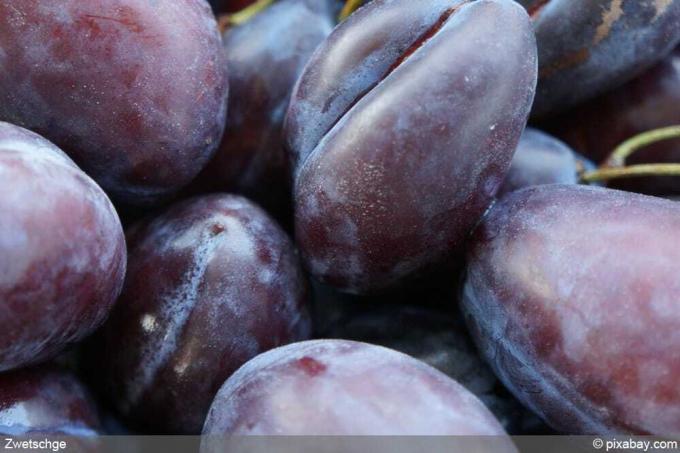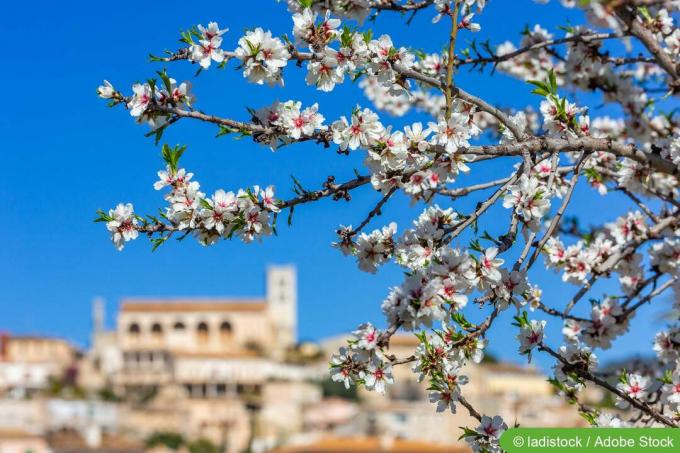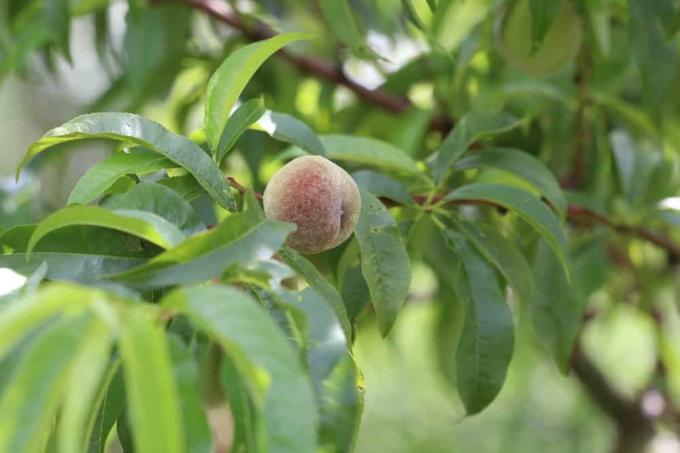

Table of contents
- location and soil
- watering and fertilizing
- Plant
- multiply
- Cut
- Harvesting and processing plums
- diseases and pests
Sweet, aromatic and healthy: Anyone who has ever tried plums from their own cultivation will no longer be satisfied with products from the supermarket. The trees can be easily grown and cultivated if the right location is selected and a suitable substrate is used. The hobby gardener should only pay attention to diseases and pests. With good care, a rich harvest of the popular fruits awaits in late summer and autumn.
location and soil
Plums need sufficient heat to develop aromatic fruits. For this reason, the fruit trees feel particularly good in a warm, sunny location; partially shaded locations can significantly impair fruit development. In order for the plant to thrive optimally, the right substrate is also necessary. The plum tree grows best when the soil used has the following properties:
- rich in nutrients
- sufficiently moist
- sandy-loamy composition
- good ventilation
A notice:
If the garden soil is rather nutrient-poor, the deficit can also be compensated for with the help of annual composting. In addition, optimal soil moisture plays an important role for the plum tree to thrive; Although the substrate should tend to contain a lot of moisture and must never dry out, waterlogging can also lead to problems. It is therefore important to ensure that there is sufficient flow.
watering and fertilizing
Targeted irrigation and careful fertilization are important prerequisites for a high-yield harvest, in addition to the optimal location. Especially trees that have just been planted need a lot of water in the beginning until the roots have developed well. Afterwards, it usually no longer has to be watered in a targeted manner, provided the plum tree is located in an area with a medium frequency of precipitation. However, persistent dry periods in summer also require additional irrigation in these areas. The following are particularly suitable for casting:
- rainwater
- pond water
- stagnant water from the tap
Fertilization is also particularly important for the plum tree when it is young. Targeted administration of nutrients via fertilizer, which should be given out once a year, works best. When watering and fertilizing, the stem of the plum should also be checked from time to time; the fruit tree tends to develop moss and lichen. In order to specifically counteract this development, regular trunk care is required, which is done by brushing with a wire brush.
Plant

Basically, the hobby gardener differentiates between three different forms of plum trees:
- tall,
- semi-stem and
- low-stemmed varieties.
The following applies: the smaller a plum tree is, the faster it will later bear fruit. The disadvantage: These variants have a shorter lifespan than varieties with larger growth. The choice of strain should therefore be carefully considered. But no matter which variant the hobby gardener chooses: the planting time is always the same; from autumn to spring it is possible to settle the plant in the garden. Before planting, the roots and shoots of the tree should first be trimmed to facilitate growth.
Then the planting hole is dug, which should be slightly wider than the root ball and so deep that the roots almost completely disappear into the substrate. After planting, the young trees must be carefully watered. A wooden pole as an additional support has also proven its worth; To do this, a strong wooden stick is stuck into the ground, to which the tree is tied. So it is exposed to less stormy winds in the beginning.
multiply
Plums are very easy to propagate; this works best with the help of the fruit core. If you open the shell with a hammer, you can quickly get to the core, which is then stored in the freezer for three to four days. This makes cracking much easier. With the help of the exposed core, the plant germinates more quickly.
The core is then planted:
- A small flower pot is sufficient for the cultivation.
- A mixture of garden soil and plant soil (50:50) is suitable as a substrate.
- The plum stone is covered with two centimeters of soil.
- At constantly low temperatures, the seeds germinate within eight weeks.
Tip:
It has proven useful to use garden soil for the cultivation that has already come from the future location.
In the cultivation phase, the temperatures should be between 5 and 10°C; If propagation occurs in this way in the cold season, a wind-protected place in the garden should be sought for this. During the summer months it is necessary to put the flower pot in the fridge for two weeks. An alternative cultivation method consists in cultivating the core on kitchen paper. To do this, a total of five pieces of moist paper are stacked on top of each other, on which the core is then placed. In this way, winter conditions are simulated. As soon as the first seedlings are visible, the move to the flower pot can take place.
If you start propagating in winter, you can look forward to a small seedling in early spring. This must then be supplied with plenty of light and a constantly moist soil. After no more frost is to be expected, the little plant is then moved to its future location. Young plants also need winter protection during the cold season - especially if the sapling is not in a sheltered location. Garden fleece, for example, is suitable for this.
Cut
Plum trees need to be pruned for a number of reasons:
- education cut
- yield cut
- Care cut (trimming)
If you want to cut your plum tree, you should choose the best time to do so. Basically, the wood is cut after the harvest. Late autumn is a possible pruning time; However, it must be ensured that the pruning does not take place immediately before the onset of a frost period. There must still be sufficient time for the cut surfaces to dry out before frost sets in. Otherwise there is a risk that the branches will freeze. Alternatively, the plum tree can also be cut in early spring as soon as the frost-free period has started.

Young plum trees first receive an educational pruning, which should only be carried out two years after planting the tree. This is done to ensure that the crown branches grow as horizontally as possible, so that the branches that naturally grow vertically upwards do not get in each other's way over time. Only a single vertical center shoot is left on the tree. If the tree finally grows in the correct form, only the maintenance pruning, the annual maintenance pruning, needs to be carried out. The crown should be kept as light as possible. All branches that grow too narrow, inward or steeply vertical are removed. Dry and drooping branches should also be removed.
When cutting, the hobby gardener considers the following aspects:
- The cut is made from the outside to the inside.
- Sharp cutting tool is used for cutting.
- Root suckers that form on the trunk must be removed.
- Interfaces are to be sealed with wound closure paste.
Harvesting and processing plums
In the period between July and October, the fruit on the plum trees ripens. It has proven itself to time the harvest at the right time; the experienced hobby gardener recognizes a ripe plum by its colour, which should be deep blue. It should be noted that not all fruits ripen at the same time as they receive different amounts of sun. This means that normally several crop spurts have to be planned for.
Small plum trees are harvested by picking the fruit by hand. If larger quantities of plums accumulate, they can also be shaken off the tree.
Freshly picked fruit tastes best on its own. In addition, however, further processing is also possible; for example, cakes or jams can be made from the blue-violet fruits. The fruit is also suitable for freezing; then the plums must first be halved and pitted. Another way to preserve it is to boil it down.
diseases and pests

Some plum varieties are particularly susceptible to diseases and pests. A classic disease is the pocket disease, which is easy to recognize due to its typical damage:
- Fruit grows like a banana
- a light green coating forms on the fruit
- Coating later turns gray and mealy
- Fruits remain hard and inedible
The disease can develop, especially in rainy weather, and can only be combated by completely removing the affected parts of the plant. Another typical disease is plum rust, which can be recognized by black dots on the undersides of the leaves and yellowing of the leaves. The Monilia fruit rot, on the other hand, presents itself as a white pustule on the plum and causes the fruit to turn black. In this case, too, only the complete removal of all affected parts of the plant helps.
The most common pests that can attack plum trees include plum moths and aphids. Both should be combated in good time with the help of a mild pesticide. However, if you take good care of your plum tree, you will rarely have to deal with diseases and pests. Careful care ensures healthy growth of the tree - and many delicious plums with which the hobby gardener can sweeten the summer and autumn.
 garden editorial
garden editorial I write about everything that interests me in my garden.
Learn more about fruit trees

Life on Mallorca: highlight almond blossom
Life on Mallorca offers a lot more than sun, summer, beach and Ballermann. The beginning of the year on the popular holiday island is all about blossoming almond trees. We'll tell you when and where you can best enjoy the almond blossom on Mallorca.

Cutting sour cherries: 21 tips for the right cut
In order for a sour cherry to remain productive year after year, it must be pruned regularly. Wood that has been removed must be removed and new fruit wood must be promoted. This only works if the "editor" knows the editing rules.

Is the ornamental peach edible? | 15 tips for care and cutting
The ornamental peach can be a decorative addition to the garden as early as March, when the trees, which are up to three meters high, are in bloom. Here we tell you how to look after them and whether their fruits are edible.

20 old apple varieties | List of old apples in & around Germany
Hardly any type of fruit is as diverse as the apple. The number of apple varieties worldwide is estimated at over 20,000. Old apple varieties are those that were discovered before 1950. We have compiled a list of popular, old varieties for you.

Peach Tree Diseases: Leaves curl or turn yellow
Among the fruit trees, the peach tree is one of the most susceptible to diseases. It often has to contend with fungal diseases such as curling disease. Here you can find out which other tree diseases can affect it, how to recognize them and how to fight them successfully.

Half-trunk cherry and apple trees: planting distance and care
Fruit trees definitely belong in every garden. But what to do if the garden is too small for a large tree? Then trees that were grown as half-stems can help. They take up less space, but deliver lots of fruit. More about this here.



